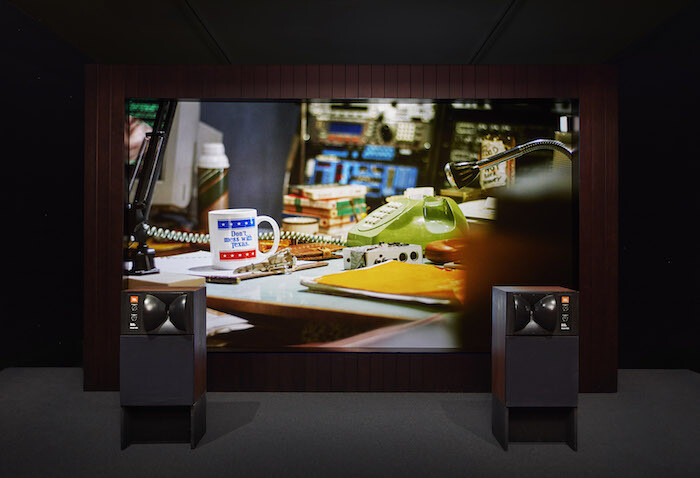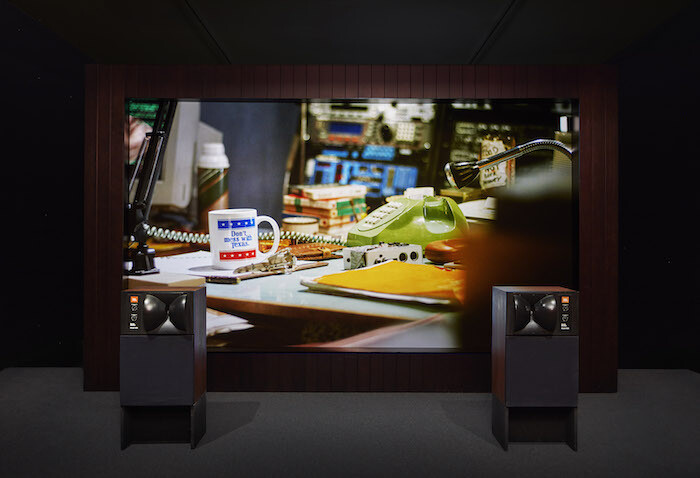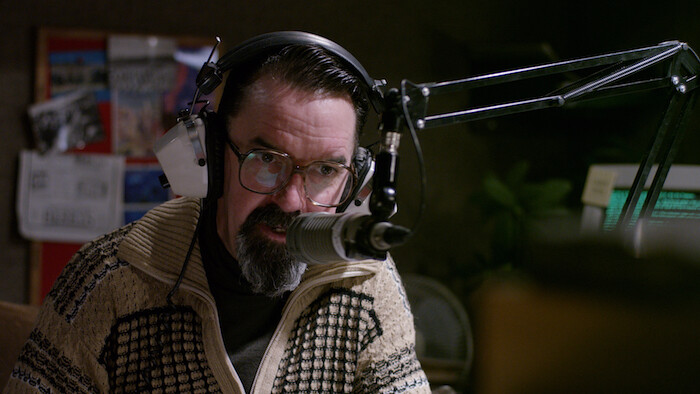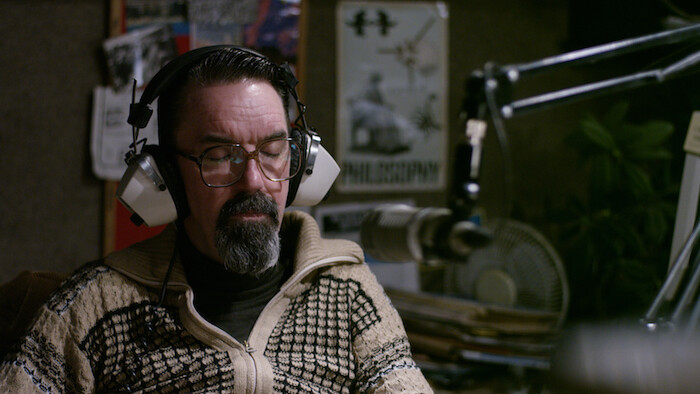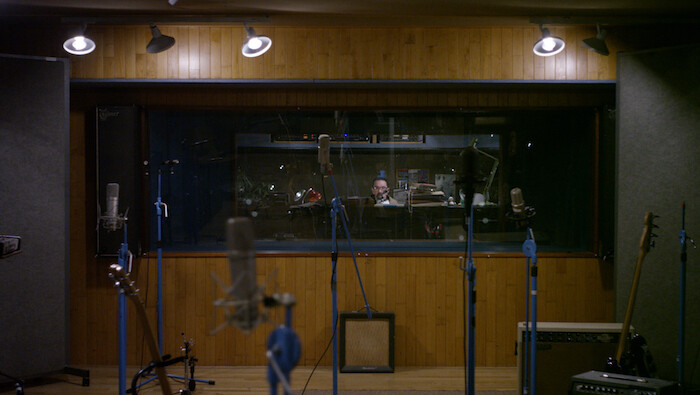The year is 1977. Iggy Pop just released “The Passenger,” Eric Clapton mourns his son’s death in the 1990s-hit “Tears in Heaven,” and Ronald Reagan’s nuclear weapons build-up has the world holding its breath. Time is warped in Gerard Byrne’s seamless amalgamation of historical events, rock hits, and news reports from different years and political eras. With a hint of nostalgia and a subtle dose of humor, his film installation In Our Time (2017) takes us on a vortexed journey through the past, dodging monolithic history for ambiguity, conjuring an image distorted by our fallible memory and extending to inhabit the present.
Byrne is a master of reconstructions, of revisiting and restaging situations from recent history. In the three-channel video New Sexual Lifestyles (2003), he convened actors to appear on a panel that was originally published by Playboy in 1973 to debate “emerging behavior patterns, from open marriage to group sex.” The cameras circle around the cast, who impersonate figures such as the sex educator Betty Dodson, Deep Throat (1972) star Linda Lovelace, gay church founder Troy Perry, and Al Goldstein, editor of the pornographic weekly tabloid Screw. They speculate about a future that now lies in the past, though some of the expressed liberal views and moments of transpiring sexism seem poignantly contemporary.
In Our Time is similarly crafted with care and brimming with references. Previously exhibited at the Münster City Library as part of Skulptur Projekte last summer, at Galerie Nordenhake the entire gallery is set up to emulate a radio booth, including pieces of auxiliary audio equipment. The film is accessed via a red curtain, as if stepping through a Brechtian fourth wall, and projected onto a centered screen with two floor-mounted vintage speakers installed in front of the image to partly hinder the view. Byrne’s camera hones in on a charismatic, dark-haired radio host—perhaps an homage to DJ Wolfman Jack—then hovers over the meticulously staged studio equipment and captures band roadies as they set up their instruments and play a few tunes. The moderator reads the news, announces the weather forecast, reports on traffic, and plays legendary rock songs from Norman Greenbaum to Annie Lennox and The Velvet Underground.
The film is set in our time, producing a conflation of filmic and real time à la Christian Marclay: the broadcast runs for 12 hours, and while the images repeat every 30 minutes, the sound layer changes. After watching for a while, incongruities become apparent. Within each loop, the name and location of the station change from KGBS, a 1960s Hollywood-based country music channel, to KFOG, a radio from San Francisco whose devoted listeners were called “Fogheads.” Similarly, the name of the host switches, and even though I know too little about some of the references on offer, searching for Bill Thompson led me to a radio actor known for several episodes on CBS, and for being the voice of Uncle Waldo in the 1970 Disney classic The Aristocats. The newscasts report on actual events, such as the Gulliver’s nightclub fire in 1974 and the murder of Alberta King in the same year, but are conflated with affairs from the Reagan Era. Consistently, the title of the work references a BBC Radio 4 series, on air since 1998.
In Our Time revisits the last decades before the internet, when news broadcasts reached a collective listenership, and before on-demand streaming, when we had to wait for hours for our favorite song to come on. The freedom we gained also scatters us in time. At certain moments, the film evokes a mawkish longing for ostensibly simpler, slower, analog times. As we grapple with uncertainty in our “post-truth” present, acknowledging the constructed nature of truth and capriciousness of memory is pivotal. The film, much like Byrne’s previous works, explores historical biases, which—even though they have arguably, though not sufficiently, improved—are threatening to relapse: most of the songs are by white, male bands, and the deep-rooted chauvinism of the music industry becomes apparent when tension increases as the moderator teases a caller-in to share the name of her new boyfriend.
Perhaps the strongest scene is when the host reads out current affairs, and a mod-styled woman, presumably the better-informed assistant who summarized the news, hands him a “Don’t Mess with Texas” novelty mug with a hint of irony. Originally a slogan against littering the state’s highways, the phrase gained cult status, appearing in Stephen King novels and advertisements starring country star (and Americana personified) Willie Nelson. Byrne, who was born in 1969, focuses on the North American context, paying tribute to the playlist of his coming-of-age, and nods to pop culture as a reflection of geopolitical power. The CIA’s support for ideologically aligned artists and musicians during the Cold War era comes to mind, while the film’s allusions reach up to George W. Bush, who dropped the Texas line in his acceptance speech at the Republican National Convention in 2000. Byrne points to the formative factors of pop culture, cyclical trajectories of collective memory, and emerging structures of feeling that can be inferred by reading between the lines. Yet, nothing is straightforward in his slippages and loops. Time is out of joint.
